http://artofmanliness.com/2011/05/13/how-to-shoot-a-rifle/
How to Shoot a Rifle
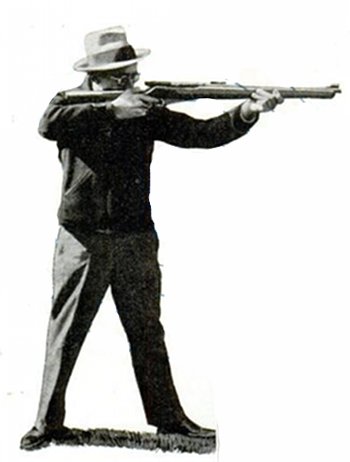
From some men, learning how to properly and safely fire a rifle is a skill they picked up when they were just knee high to a grasshopper. These guys probably got a .22 for their 12th birthday and spent summers in the woods plinking tin cans and squirrels and autumns hunting deer with their dads and grandpas.
Me? I wasn’t one of those guys.
But lately I’ve been wanting to learn how to fire a variety of firearms. I’m sure there are other men out there who, like me, went their entire life not ever shooting a rifle, but now have the desire to learn. It might be because he wants to take up hunting. Maybe he’s interested in home protection. Or perhaps he’s just interested in marksmanship as a hobby in and of itself. Whatever your reasons are for wanting to learn how to fire a rifle, you need to know how to do it safely and correctly.
A few months ago we did a post on firing a handgun safely and correctly. This time we’ll focus on how to shoot a rifle. So I headed back over to the U.S. Shooting Academy here in Tulsa, OK to talk to Mike Seeklander, Director of Training at the Academy. He explained the very basics of firing a rifle and today I’ll share what I learned with you.
The Four Cardinal Safety Rules of Firing a Rifle
Just as he did when we talked about firing a handgun, the very first thing Mike brought up were four rules, that if followed strictly, will keep you and others safe so you can have a good time firing off a few rounds.
1. Always treat every firearm as if it were loaded. No ifs, ands, or buts. Even if you know the gun is unloaded, still handle it as if it were loaded.
2. Always keep the firearm pointed in a safe direction, a direction where a negligent discharge would cause minimum property damage and zero physical injury. The safest direction to point a gun is always downrange (as long as there aren’t any people downrange!).
3. Always keep your trigger finger off the trigger and outside the trigger guard until you have made a conscious decision to shoot.
4. Always be sure of your target, backstop, and beyond. You want to be aware of what’s in your line of fire. This isn’t usually a concern if you go to a professional gun range. They make sure that people and property stay out of the path of the guns firing downrange. Where this becomes a concern is when you go shoot with your buddy out on his property. This is especially important when firing high powered rifles as their bullets travel further than bullets fired from a handgun.
Listen to Mike: “Ask your friend what exactly is beyond the target and backstop you’re shooting at, especially when you’re shooting into a wooded area. Don’t just settle for, ‘Oh, don’t worry. There’s nothing back there.’ Ask specifically if there are any houses, property, etc beyond your backstop. Err on the side of being overly cautious.”
Types of Rifles
Rifles are high powered firearms typically used to hit targets at long distances. Rifles are designed to be fired from the shoulder. Grooves, called rifling (hence the name rifle), are cut into the barrel of a rifle. Rifling makes the bullet spin as it leaves the muzzle, making the bullet much more accurate and stable in flight.
There are a variety of rifles out on the market that serve different purposes. Here’s a quick rundown of the most common.

Bolt action rifles. Hunters often use a bolt action rifle like the Winchester Model 70 which requires the shooter to manually open and close the breech of the gun to eject a spent casing and load a new one.

Lever-action rifles. If you’re a fan of Westerns, you probably noticed the cowboys in the films firing lever-action rifles. Lever-action rifles use a lever located around the trigger guard area to load fresh cartridges into the chamber of the barrel when the lever is worked. The most famous lever-action rifle of the Wild West was undoubtedly the Winchester rifle, a favorite firearm of badasses like Bass Reeves.

Semi-automatic rifles. A semi-automatic rifle fires a single bullet each time the trigger is pulled, automatically ejects the spent cartridge, and automatically chambers a new cartridge from a magazine. Most modern semi-automatic rifles are made from lightweight synthetic materials that make them easy to hold and carry. The most popular semi-automatic rifle is the AR-15. Here in the United States, there are no federal restriction on civilians owning AR-15s, though some states, like California, do place restrictions on ownership. Other states, such as Texas, have no restrictions and even allow semi-automatic rifles for hunting. The rifle Mike used in our photos was a JP-15.
How to Stand When Firing a Rifle
There are two common stances when firing a rifle: bladed-off and a squared, “athletic stance.”
Bladed-off stance. A bladed stance is when your weak-side shoulder is facing the target. So if you’re right handed, your left shoulder is facing the target; if you’re left handed, your right shoulder faces the target. It sort of looks like how a baseball batter would stand in the batter’s box. Here’s Mike, showing a bladed stance:
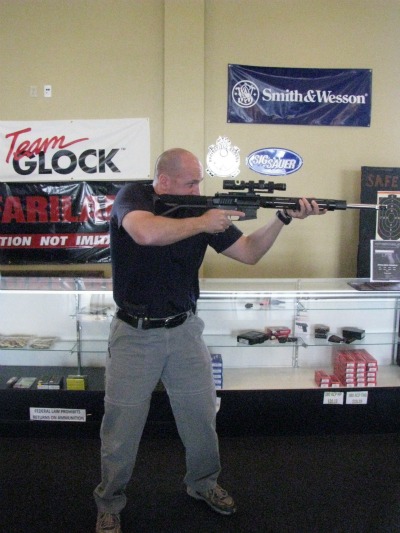
Bladed-off Stance
Many first-time shooters stand in a bladed-off stance when firing a rifle. They probably saw their favorite cowboys or action heroes in movies take this stance, so they assume it’s the best way to stand. Mike says that while a bladed stance is good for competition shooters who need precision in their aim, it’s not a great stance for shooters in more tactical situations that require rapid shots with minimal muzzle rise.
Squared or athletic stance. Mike and the folks at the U.S. Shooting Academy teach their students to assume an athletic stance when firing a rifle. Square your shoulders up with the target. Stand with your feet shoulder-width apart on a straight line. Stagger your strong side foot about six inches behind your weak side foot.
Place the buttstock of the rifle near the centerline of the body and high up on the chest. Keep your elbows down.
Here’s Mike now showing the athletic stance:

Athletic rifle stance
The biggest advantage of the athletic stance over the bladed stance is that it helps in reducing the effects of recoil when firing a rifle. Think about it. If you’re a lineman in football and you want to resist the other guy pushing you backwards, what stance would give you more balance? Being squared up with the other guy or standing sideways with just one of your shoulders towards him? Squared up, of course.
Another advantage the athletic stance has over the bladed stance is that the athletic stance allows you to track a moving target better. A bladed stance limits how much you can twist your body. An athletic stance allows you to swivel right or left much more easily.
Mike recommends an athletic rifle stance for most shooting situations.
How to Hold a Rifle
Trigger Hand Grip
Rifle with pistol grip. If your rifle has a pistol grip, like the AR-15 or JP-15, center the grip in the “V” at the junction of the thumb and index finger of your trigger hand. Grip the gun high on the back strap (the back strap is the back of the grip on the gun). Like so:
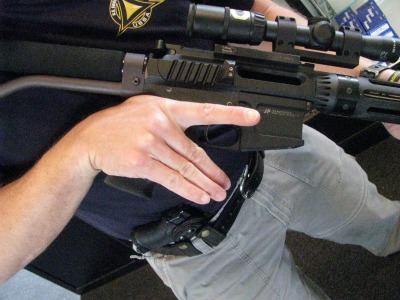
Rifle without a pistol grip. Most bolt action or lever action rifles don’t have a pistol grip like the AR-15. What they typically have instead is a crook between the stock and the trigger guard. Like so:

With these sorts of rifles, center the nook in the “V” at the junction of the thumb and index finger of your trigger hand. Grip the gun high on the nook.
Support Hand Grip
The support hand should grip the forestock (or handguards if you’re shooting an AR-15) of the rifle roughly midway down the length of the rifle. Here’s Mike demonstrating for us:
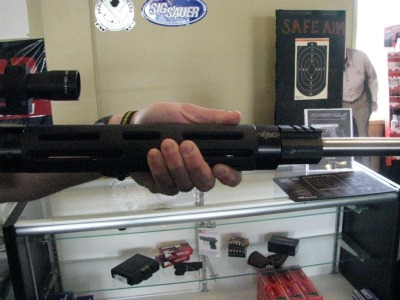
Putting your support hand further forward on the forestock will give you finer control over the muzzle when aiming, which you want when precision is key. The disadvantage of putting your support so far out on the forestock is that it’s a little less stable.
Bring the rifle to your head and press your cheek firmly into the stock. Keeping your head up, bring the rifle to your head. Place the buttstock of the rifle near the centerline of the body and high up on the chest. Press your cheek firmly to the side of the stock of the gun, like so:
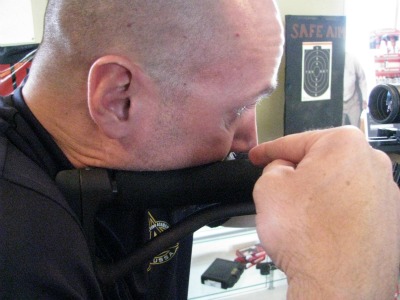
Mike demonstrating proper cheek lock.
You’re now ready to aim and fire your rifle.
How to Aim a Rifle
Rifles can have different kinds of sighting systems depending on what you’re using your rifle for. What sighting system a rifle has also depends a lot on the preference of the shooter. Three common sighting systems you’ll see on a rifle are: open sights, aperture sights, and scope sights.
Aiming a Rifle with Open Sights

Aiming through open sights.
Open sights use a notch of some sort as the rear sight. They come standard with most rifles. We talked about how to aim with open sights in our post about firing a handgun. The same principles apply here. I won’t repeat what I wrote, so refer back to that post for tips on aiming a rifle with open sights.
Aiming a Rifle with Aperture Sights

Aperture sight
Aperture sight (or peep sight) rifles have a similar front sight to open sight rifles. The difference is the rear sight. Instead of an open notch, the rear sight is a small ring mounted close to the shooter’s eye. There are different kinds of aperture sights, the most common being the ghost ring sight.
Aperture sights allow you to acquire your aim more quickly and more accurately than when using open sights. One of the problems with open sights is that it forces the eye to focus on three objects at the same time: the rear sight, the front sight, and the target. This is impossible to do, so one of the points of focus will be blurry. Aiming an open sight gun requires the shooter to know which object needs to be blurry and which objects need to be in focus. Focusing on the correct points can take precious time.
Aperture sights speed-up getting a correct sight picture by removing one of the objects in the shooter’s line of sight, specifically the rear sight. Looking through the rear ring causes your eye to automatically center on the front sight at the muzzle of the gun, thus providing you with a more accurate aim, acquired more quickly compared to using an open sight.
To aim with an aperture sight, simply look through the rear ring sight, attempting to only focus on the front sight and the target. The ring will blur until it is almost invisible (hence the name, ghost ring sight).
The front sight should be centered in the rear ring. The greater the distance to the target, the more perfectly you need to center the front sight in the rear ring. A closer sight requires less sight precision. Aim your front sight right underneath the point you want the bullet to hit. Before firing, shift all your focus to the front sight.
How to Aim a Rifle With a Scope
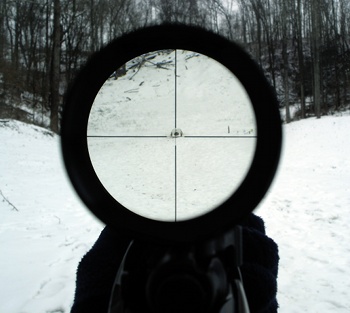 Scopes provide the most accurate and easy sighting on a rifle. They allow the shooter to magnify their target for better target definition at long ranges. A scope’s most useful attribute is that everything in the shooter’s field of view is in the same optical plane. Translation: there’s no need for your eye to balance focusing on multiple objects like you do with open sights and aperture sights. You can keep both the crosshairs and the target in focus. Just aim your cross hairs at your target and shoot.
Scopes provide the most accurate and easy sighting on a rifle. They allow the shooter to magnify their target for better target definition at long ranges. A scope’s most useful attribute is that everything in the shooter’s field of view is in the same optical plane. Translation: there’s no need for your eye to balance focusing on multiple objects like you do with open sights and aperture sights. You can keep both the crosshairs and the target in focus. Just aim your cross hairs at your target and shoot.
Well, I wish it were that easy. A novice shooter might notice that despite a steady hand, all their shots end up nowhere near the crosshairs of the scope. For maximum accuracy with a scope, you have to “zero” it. Zeroing a rifle is a somewhat technical process for a beginner shooter and warrants its own article explaining how to do it. I’ll do a follow-up article on how to zero a scope in the future.
Trigger Management (aka Pulling the Trigger)
To fire a gun, we often use the popular phrase “pull the trigger.” However, to fire a gun properly, you don’t actually want to pull the trigger, but rather press it in a controlled fashion so you don’t disrupt your sights. Managing the trigger on a rifle is similar to doing so on a handgun, so here’s a review of the basics we covered last time:
1. Press, don’t pull. Instead of pulling the trigger, press (or like my dad likes to say “squeeze”) the trigger straight to the rear. Apply constant, increasing reward pressure on the trigger until the weapon fires. Ensure that you’re only applying pressure to the front of the trigger and not the sides.
2. Take the slack out of the trigger. Squeeze the trigger to the point you start feeling resistance.
3. Surprise yourself. Keep pressing the trigger straight to the rear until the gun fires. Don’t anticipate when the gun will fire. You sort of want to surprise yourself as to when the gun actually discharges.
Have any other tips for the first time rifle shooter? Share them with us in the comments!
Editor’s note: This article is about how to fire a rifle safely and correctly. It is not a debate about gun rights or whether guns are stupid or awesome. Keep it on topic or be deleted.
_____________________________________________________________________________
Special thanks goes out to Mike and the crew at U.S. Shooting Academy for their help on this article. Mike along with the U.S. Shooting Academy Handgun Manual were the sources for this article. If you’re ever in the Tulsa area, stop by their facility. It’s top notch and the staff and trainers are friendly, knowledgeable, and super badass.

← Previous Comments
Bigd-
Your statement saying that the .223 wasnt meant to kill is quite possibly the stupidest thing i’ve ever read on this board. When we were in basic, they didnt instruct us to “aim center mass” to wound. I venture that more than one Viet Cong, Iraqi and Afgani would argue your point if they were still above ground to do so.
I think there would be a lot less blanket “anti-gun” people if more people learned about them, their use and laws and practiced shooting.
Well, this has certainly been an educational experience. I offer a post in which I comment on 4 items, the most important of which is responsibility for the bullet that is fired. The only comments I get back concern the least important item, which is my preference regarding the AR.
First, let me state that I have fired an AR (or copy) a number of times, but never in combat. I am impressed with this style of gun. It is very accurate and tolerates a lot of abuse. And yes, the .223 (5.56) is a great cartridge. I would not deny that fact. And yes, AR-style guns are now available in a variety of calibers.
Now having admitted this, let me make a few other comments.
1. My dad was in WWII. He used a .30 M1 carbine. This gun was intentionally designed to wound the enemy, not kill him, since it takes a lot more enemy manpower to deal with a wounded soldier than a dead one.
2. When the guys came back from WWII, there were some attempts to use the .30 M1 carbine round for hunting. These were generally not successful. There are numerous references to this fact.
3. There are a number of states that outlaw the .223 caliber for deer hunting. The rational is that a .223 bullet will not provide a humane kill on an animal that is approximately the size of a man.
4. Yes, I understand that a hot-loaded, WELL-PLACED, .223 caliber expanding bullet will put down just about any game animal in North America.
5. All I am saying is that when the bad guys start coming over the distant hill, the Geneva Convention be damned, I will be using a bolt-action rifle to toss .35 or .45 caliber expandable bullets in their general direction.
Join the USMC and they’ll teach you how to shoot a rifle, pistol, machine gun, and many other neat toys. You definitely will not learn how to shoot by reading this article. Still a neat article, though.
Find a appleseed near you. Learn to be a rifleman, For more info, check out http://www.appleseedinfo.org
Thank you for including the bladed off stance. In this day and age the focus on tacticool firearms and techniques has frequently overridden the classics. I can’t count how many times I’ve been at the range and heard the arm chair commandos’ criticisms of mine and other shooter’s “chicken wing” stance. I hunt hogs and whitetail I’m not storming an enemy bunker.
I think this is a perfectly good primer on rifle shooting and one certainly could accomplish it simply by reading this article and going to it. There are certain nuances in the Army method that are worth reading about and one can buy their standard training manual rather than enlisting. The finer stuff about wind compensation and the like can be added later. All of the bores that insist you need “professional training” for everything will insist you pay someone to teach you how to do everything including how to have sex with your own wife. A real man reads a good book and gives it a try himself.
Biged: I don’t know of any weapon that’s designed to “wound” an enemy, and not kill.
There were GI complaints about the M1 carbine’s alleged lack of stopping power (some in WWII, mostly Korea), but this may have come from underpowered issue ammo and heavily bundled-up troops (winter phases of the Korean War), as well as the full-auto version’s muzzle climb carrying the rounds over the heads of the enemy.
.30 carbine rounds charged properly have ballistic power roughly equal to a .357 Magnum, which was certainly not designed to “wound, not kill” an opponent.
There’s some definite misrepresentation going on here. Most semi-automatic rifles do not resemble military firearms like the AR-15 at all. There are plenty of semi-autos that maintain the classic form factor of a traditional bolt action. I love AR’s as much as the next guy, but lets not scare off the people who are new to guns by misinforming them in such a way. Also, the statement that ‘most modern semi-automatic rifles are made of synthetic materials’ is also a little off. Otherwise, great article. The instruction and tips are great, and anything that might encourage someone to get into shooting is great.
New to this place, love it. I second XJ88, the AR image might be overbored for some people. Especially the kind of folks who might need this article to be introduced to shooting. If you choose to revise the article, I feel the Remington 7400 and 7600 need mentioning. One is a semi-automatic Hunting rifle, not assault rifle, and the other is a pump action hunting rifle, which is missing from your list of rifle varieties. Thanks for the great articles sir.
New to this place, love it. I second XJ88, the AR image might be overboard for some people. Especially the kind of folks who might need this article to be introduced to shooting. If you choose to revise the article, I feel the Remington 7400 and 7600 need mentioning. One is a semi-automatic Hunting rifle, not assault rifle, and the other is a pump action hunting rifle, which is missing from your list of rifle varieties. Thanks for the great articles sir.
Good article, Brett. In addition, it would be good to address breathing pattern and possibly the kneeling and prone stances. I’m definitely glad that your first order of business was to cover safety. No one wants a jackass waving their loaded weapon around at them. Well done.
I’m new to shooting, so the cheek lock idea was something I’d never heard of. My shooting is much improved from that tip alone. Thanks for taking the time to write useful stuff.
I’ve read half a dozen of your articles, thank you for actually creating a well thought out and concise article. I have yet to find a single spelling or grammatical error.
Awesome job.
Aaron,
Thanks for your comment.
One of the problems with your argument is that you are comparing .30 M1 caliber full metal jacket “Geneva convention” ammo to .357 hollow points.
There is definitely a theory relating to the wounding of a soldier vs. killing him in terms of utilizing enemy manpower. I think I read of the use of the .30 M1 carbine round for this purpose in “The Rifle in America” by Philip B. Sharpe. I need to pull this reference out and double check.
I dunno. It might be a sign of “over –maturity” (i.e. old age), but I’d rather be out hunting with other hunters that have to work the action of their guns for each shot rather than using a semi-auto. If you want to try to relate this to the military, than maybe hunting is closer to sniping than battlefield war. Hunting is really about stalking the game animal and making the first shot count. It is humane to down the animal as quickly as possible. And if you need a “30 shot clip in reserve” as another comment has suggested, then I have to wonder if we’ve lost track of the purpose of hunting.
On a brighter note, my 9-year-old is still using his “Red Ryder” Daisy b-b gun to perforate cans out back. My wife and I talked about getting him a .22 this year, but we decided to wait. He shoots my .22 rifles and pistols with supervision, but getting his own .22 is a sign of responsibility. I’ve got a sneaking suspicion that if more parents exposed their kids to guns in a graduated way like this, we would not have half of our world problems.
……………………….
I debated about making this next comment, thought about it for quite a while….. and I guess I’m willing to bring down the wrath of the western world on myself for making it.
“If you don’t have space in back of your McMansion for a kid to shoot a b-b gun then “P*ss on You!”
(Pardon my vernacular.)